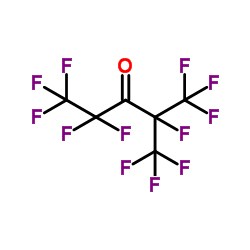Perfluoro (2-methyl-3-pentanone) FK-5-1-12
Published date: 2020-12-12 14:36:26
| Name | Perfluoro(2-methyl-3-pentanone) | CAS# | 756-13-8 | |
|---|---|---|---|---|
| Price | $Inquiry/1kg | Purity | 99.7% | |
| Stocking Period |
Inquiry | Stock | In Stock |
| Detail
Product Information
Product name: Perfluoro (2-methyl-3-pentanone) Synonyms: FK-5-1-12; Dodecafluoro-2-methylpentan-3-one; C6 Fluoroketone CAS No.: 756-13-8 EC No.: 436-710-6 Molecular formula: C6F12O Molecular weight: 136.045 Molecular structure: Chemical code: FK-5-1-12 Introduction: Perfluoro (2-methyl-3-pentanone), used as safe, clean fire extinguishing agent with high efficiency, is a new-generation halon alternative offering outstanding performance, a large margin of safety, and low environmental impact. Its ASHRAE nomenclature, the way it is designated in the NFPA and ISO 14520 clean agent standards, is FK-5-1-12. Perfluoro (2-methyl-3-pentanone), is a novel substitution of halon extinguishing agent. It features zero ozone depletion potential (ODP) and a global warming potential (GWP) of less than 1. It also has the largest safety margin for use in occupied spaces of all clean agents. It effectively extinguishes fire faster than inert gas or water mist systems, requires less volume of fluid and is safe for use with electronics. Physical properties: It is colorless, transparent liquid at room temperature, but applied as a gas. It is electrically non-conducting in both the liquid and gas state. The boiling point is 49.2 deg C, meaning it has a much lower vapor pressure than other clean agents, which are gases at ambient conditions. It has a very low heat of vaporization, approximately 25 times less than that of water. This, along with a vapor pressure 12 times higher than water causes it to evaporate more than 50 times faster than water. This allows the agent to transition from a liquid to a gaseous state very rapidly. When discharged through a nozzle from a properly designed system, it will rapidly vaporize and evenly distribute throughout the protected space. It has the highest heat capacity of the commercially available halon alternatives resulting in the lowest extinguishing concentrations for a given fuel. The design concentration for Class A combustibles is a minimum of 4.5 vol% for designs based on UL 2166 in the USA. Properties deion: Properties Value Molecular weight 316.045 Boiling point at 1atm 49.2℃ Freezing point -108℃ Critical temperature 168.7℃ Critical pressure 18.65 Bar Critical density 639.1 kg/m3 Heat of vaporization at boiling point 88.0 kJ/kg Liquid Viscosity @25℃ 0.524 cp Solubility of water in Noah5112 @25℃ <0.001 wt% Specific heat,liquid@25℃ 1.013 kJ/kg ℃ Saturated liquid density(25℃) 1.60 g/ml Vapor pressure(25℃) 0.404 bar Insulating property (110k) 3.8mA(Standard leakage current≤10mA) Dielectric strength (kV) 74.6 kV (Test distance 3mm) ODP 0 GWP 1.0 ATL 0.014 Specifications: Appearance: Colorless transparent liquid Purity, %: 99.7 min. Acidity, (as HCl), ppm: 3 max. Water content, ppm: 10 max. Non-volatiles residue, %: 0.01 max. Certificates available: REACH, UL, FM Applications: It is used as safe, clean fire extinguishing agent with high efficiency, can effectively be applied in total and local flooding, inerting and explosion suppression applications in the areas of marine vessels, laboratories, data center, server rooms, museums and archives, oil and gas, power generation, etc. Packing: 250kg iron drum, 1100kg IBC Transport and Storage: Transport against the regulation. Store in clear, dry container under cool, ventilated and dry place, far away from fire and heat. More
|




